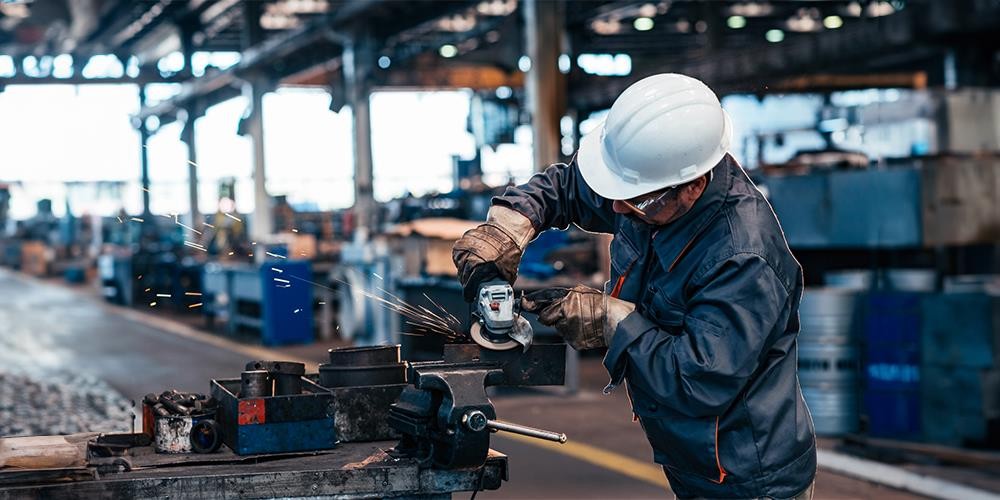New Delhi, May 2, 2025 — India’s manufacturing sector roared ahead in April, posting its strongest performance in nearly two decades, while exports surged at the fastest pace in 14 years, signaling renewed economic momentum driven by strong global demand and resilient domestic production.
According to data released by S&P Global on Thursday, the country’s Manufacturing Purchasing Managers’ Index (PMI) rose sharply to 59.5 in April from 56.6 in March, marking one of the highest readings since the index was introduced in 2005. Any reading above 50 indicates expansion.
The surge was driven by robust factory output, a rise in new orders—both domestic and international—and a remarkable jump in employment levels. This resurgence in manufacturing was mirrored by the country’s export figures, which posted a 17.8% year-on-year increase, the highest single-month rise since 2011.
India’s merchandise exports hit $44.2 billion in April, up from $37.5 billion in the same month last year. Key contributors included electronics, engineering goods, pharmaceuticals, textiles, and automotive components. Notably, exports to key markets like the United States, the European Union, and Southeast Asia saw double-digit growth, bolstered by favorable trade dynamics and geopolitical shifts that have led companies to diversify supply chains away from China.
“The data underscores a shifting tide,” said Anantha Iyer, Chief Economist at Axis Capital. “India is beginning to see the benefits of the China+1 strategy, where global corporations are de-risking their supply chains. Manufacturing in India is becoming more cost-competitive and quality-focused.”
Industry analysts point to recent government policies, including the Production-Linked Incentive (PLI) schemes for key sectors, improved infrastructure, and simplified compliance norms, as catalysts for the manufacturing revival. The PLI schemes, in particular, have attracted investments exceeding ₹3 lakh crore (~$36 billion), generating thousands of new jobs and enhancing export capacity in sectors such as electronics, medical devices, and telecom equipment.
Commerce and Industry Minister Piyush Goyal hailed the data as a validation of India’s “Make in India” vision. “This is not just a statistical uptick. It reflects years of groundwork, structural reforms, and a belief in India’s manufacturing might,” he stated.
-
Electronics: Export growth of 27.4%, led by smartphone assembly and semiconductor components.
-
Engineering goods: Up by 22.1%, supported by increased demand from European clients.
-
Pharmaceuticals: Grew by 14.3%, with demand spiking for generic drugs and APIs.
-
Textiles and Apparel: Rose 12.7%, aided by renewed orders from U.S. and EU retailers.
Ashwini Deshpande, managing director of Bharat Engineering Ltd., commented, “We’ve not seen this kind of overseas order volume since before the global financial crisis. Our challenge now is to scale quickly while maintaining quality.”
The PMI survey reported growth in new business inflows, with companies noting improved customer demand and successful marketing initiatives. International orders rose at the strongest pace since mid-2010, reflecting confidence in India’s manufacturing reliability.
Furthermore, manufacturing employment grew for the sixth consecutive month, a trend that analysts see continuing into the second half of 2025. The survey also noted increasing optimism among manufacturers, with 88% of respondents forecasting output growth over the next year.

Despite the positive data, several headwinds persist. Input costs continue to fluctuate due to global commodity market instability.
“There is a need for cautious optimism,” warned Shubhada Rao, Founder at QuantEco Research. “While exports and output are on the rise, we must remain vigilant about inflationary pressures and geopolitical risks.”
India’s import bill also saw a 12% uptick, primarily due to rising oil and gold imports, but the trade deficit narrowed slightly thanks to the strong export performance.
Globally, India stands out as one of the few major economies experiencing simultaneous growth in both domestic production and international trade. China’s manufacturing continues to show signs of stress due to regulatory pressures and weak demand, while Europe grapples with stagnation and inflation. In this landscape, India appears increasingly attractive as both a manufacturing base and a trading partner.
Indian equity markets responded with enthusiasm to the manufacturing and export data. The Nifty 50 climbed 1.2% on Thursday, while shares of major manufacturing firms, including Larsen & Toubro, Tata Motors, and Dixon Technologies, saw notable gains. The rupee also strengthened slightly against the dollar, closing at ₹81.94.
The Federation of Indian Export Organisations (FIEO) projected that India could touch $500 billion in merchandise exports for FY2025, provided global demand remains stable. Meanwhile, the government is eyeing a doubling of manufacturing’s contribution to GDP by 2030, from the current 17% to over 30%.
Economists believe that with the right policy support and infrastructure investment, India could solidify its place as a top-tier global manufacturing hub.
- Top 5 Must-Visit Gadget Stores in Muscat for 2025
- India’s electricity demand to grow at 6-6.5% over next 5 years: ICRA
- France expresses strong support for India against terrorism, trade ties deepen: Piyush Goyal
- Gulf Oil Giants Boost Output: What OPEC+ Production Hike Means for Markets and the Region
- Muscat International Book Fair 2025 Draws Record-Breaking 649,589 Visitors
- India’s growth to surge by 0.2% to 6.4% while China’s projection reduced by 0.3%: Fitch Ratings

